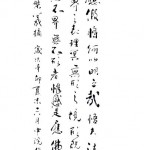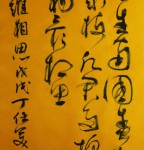Handwriting technique of Chinese Calligraphy in a broad sense includes the way to hold and use the brush to write characters. There are countless ways to wield the brush. I shall dwell only on the basic ways.
The Chinese term qi bi literally means to begin your stroke. The term shou bi means to end your stroke.
In writing characters each stroke involves qi bi and shou bi. If the stroke of a Chinese character is regarded as the basis of word construction, qi bi and shou bi are essential steps that determine the form of your stroke.
You must not make indecisive strokes -not knowing how you are going to write the strokes and where they are leading to. It will also not do if the strokes become unrecognizable-if the forceful strokes can't be told from the light strokes. If you are indecisive in writing strokes in calligraphy, your characters will be like withered trees, formless or styleless. The beginner will not be able to master the technique, but must pay due attention to the technique. Some people have been writing Chinese characters for several decades and still don't know the technique of qi bi and shou bi. They tend to neglect the technique. It is necessary to focus attention on it as you begin to write characters and cultivate good habits in writing strokes as you go along.
The basic approach to qi bi is: If you want to write a horizontal stroke, you must hold the brush per-pendicularly to begin with. To do a perpendicular stroke, begin it horizontally.
The basic approach to shou bi is: When you end your perpendicular stroke, you must make the stroke appear like dew about to drop. When you end your horizontal stroke, you must proceed to the right and then come back to the left. This process is repeated each time.
Lift And Press The Brush
When you write words on a piece of paper, you don't use the same force all the time. You first lift the brush up, then press it down. Writing involves an alternate process of lifting up and pressing down. Sometimes you do it with a heavy hand, sometimes lightly. The characters appear heavy or fine. You may do a stroke with a hook or do a downward stroke slanting towards the right. In this way the strokes give viewers a sense of rhythm.
The idea conveyed through the dot or the dash will come to life. The style of the calligraphy will appear on paper.
Zang Feng And Lu Feng
What is feng? The tip of the brush has a central part of sharp, long hair (the main part), and its sur-rounding part of shorter hair. If you spread the hair evenly, you will see under sunlight that the tip of the main hair is transparent. This is called feng -the tip of the brush. It also means the cutting power of your brush. The term zang feng refers to first and last touch of the brush tip on the paper hidden in the writing stroke. In qi bi or shou bi you do not reveal these touches. This enables the cutting power of the brush to be kept in the strokes of the characters. The zang feng stroke imparts a suggestion of power, not revealing all that is in the mind of the calligrapher. This is what the ancient Chinese call sparing your cutting power in order to contain you energy or vitality.
Lu feng, in contrast, means a deliberate revelation of the cutting power of your brush, providing viewers with a sense of sharpness. This is what the ancient Chinese describe as revelation of the cutting power of the brush to give free rein to the spirit.
The zang feng method of wielding the brush means you turn the point in the direction opposite the one intended. For example, if you want to write a stroke from left to right, begin it by pressing the brush point to the right and then moving your brush a bit to the left to write the stroke to the right. End the stroke by returning a bit to the left. The cutting power of the brush will then be contained within the stroke.
Lu feng means the tip of the brush does not come from the opposite direction. You don't keep the cutting power of the brush within the stroke. The cutting power is revealed outwardly.
Zhuang Feng And Zhe Feng
Zhuan feng is used to write a round dot. This calls for nonstop turning of the brush. Just let the tip of the brush go round and round. The dot will not become a square. Make a turn and it will be round, ancient Chinese said. This is what is meant by the term zhuan feng.
Zhe feng is used to write square strokes. The Chinese term zhe means to twist or bend. You break the line of your stroke to make a square, ancient Chinese said.
Zhong Feng And Ce Feng
Zhongfeng, or the central cutting power of the brush refers to keeping your brush point always in the middle of the stroke. In this way the strokes will be full and round, will have a three dimensional effect and will not appear plain. Ancient Chinese tended to overstress zhong feng, but they had a point there.
Ce feng means the writer uses the brush point one-sidedly or in a sidelong manner. The brush point is on one side of the stroke. Ancient Chinese described zhongfeng as a means to exert vigor, while ce feng was a means to achieve elegance or beauty. A foremost calligrapher, Wang Xizhi (303-361), wrote his introduction to the Orchid Pavilion beautifully. The beauty of his calligraphy lies in his sidelong effect. of course, he uses both zhong feng and ce feng as the necessity arises.
The ten writing skills mentioned above are not isolated. Related to each other, they form an integral movement. I have described them one by one only for the sake of convenience. Calligraphy is an art. The skills, too, form an art. As such they are the result of long practice. It is difficult to describe their details or delicate points in words. In Handwriting be sure to pay attention to each one and use them flexibly.
| < 上页 | 下页 > |
|---|













